TESCO's Competitive Strategy: SWOT, PESTLE, and Ansoff Matrix
VerifiedAdded on 2021/02/19
|10
|2767
|187
Report
AI Summary
This report provides a comprehensive analysis of TESCO's competitive strategy, focusing on the application of various strategic tools. The introduction defines competitive strategy and its importance for long-term market sustainability, emphasizing the use of tools like PESTLE and SWOT analysis. The main body delves into a SWOT analysis, identifying TESCO's internal strengths and weaknesses, as well as external opportunities and threats. It also covers PESTLE analysis, examining political, economic, social, technological, legal, and environmental factors impacting TESCO's operations. Furthermore, the report explores the Ansoff's matrix, outlining market penetration, market development, product development, and diversification strategies. The report concludes by summarizing the key findings and strategic implications for TESCO's future competitive positioning.
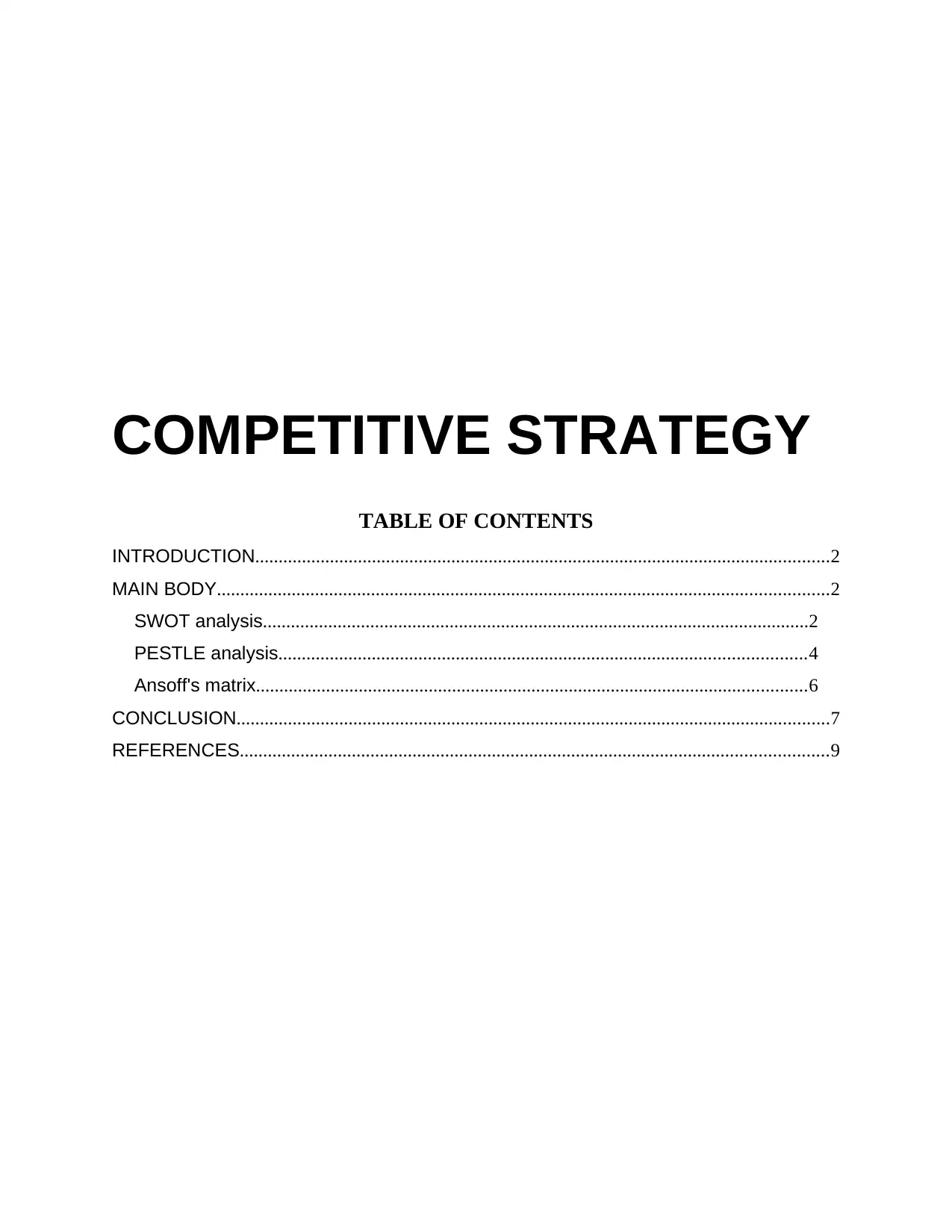
COMPETITIVE STRATEGY
TABLE OF CONTENTS
INTRODUCTION...........................................................................................................................2
MAIN BODY...................................................................................................................................2
SWOT analysis.....................................................................................................................2
PESTLE analysis.................................................................................................................4
Ansoff's matrix......................................................................................................................6
CONCLUSION...............................................................................................................................7
REFERENCES..............................................................................................................................9
TABLE OF CONTENTS
INTRODUCTION...........................................................................................................................2
MAIN BODY...................................................................................................................................2
SWOT analysis.....................................................................................................................2
PESTLE analysis.................................................................................................................4
Ansoff's matrix......................................................................................................................6
CONCLUSION...............................................................................................................................7
REFERENCES..............................................................................................................................9
Paraphrase This Document
Need a fresh take? Get an instant paraphrase of this document with our AI Paraphraser
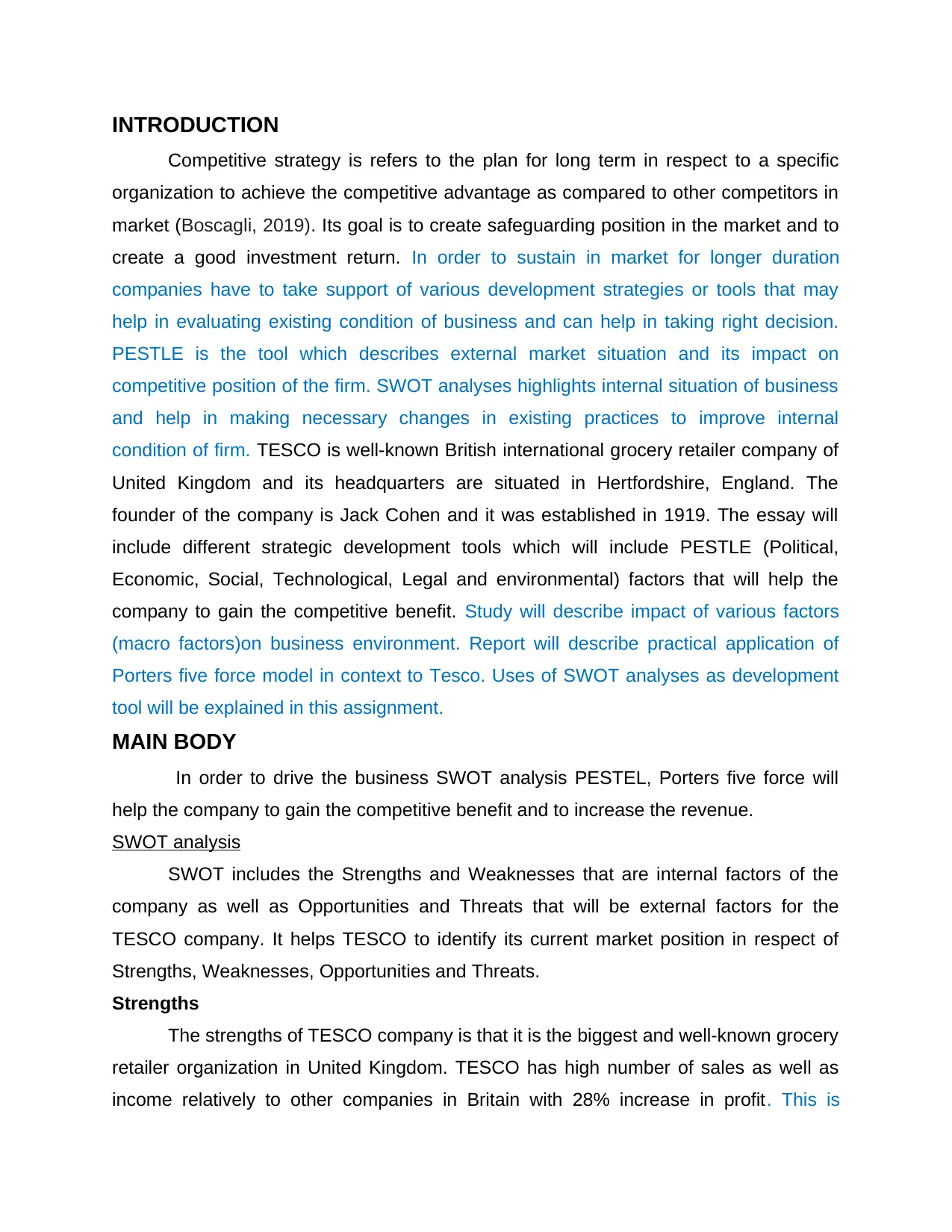
INTRODUCTION
Competitive strategy is refers to the plan for long term in respect to a specific
organization to achieve the competitive advantage as compared to other competitors in
market (Boscagli, 2019). Its goal is to create safeguarding position in the market and to
create a good investment return. In order to sustain in market for longer duration
companies have to take support of various development strategies or tools that may
help in evaluating existing condition of business and can help in taking right decision.
PESTLE is the tool which describes external market situation and its impact on
competitive position of the firm. SWOT analyses highlights internal situation of business
and help in making necessary changes in existing practices to improve internal
condition of firm. TESCO is well-known British international grocery retailer company of
United Kingdom and its headquarters are situated in Hertfordshire, England. The
founder of the company is Jack Cohen and it was established in 1919. The essay will
include different strategic development tools which will include PESTLE (Political,
Economic, Social, Technological, Legal and environmental) factors that will help the
company to gain the competitive benefit. Study will describe impact of various factors
(macro factors)on business environment. Report will describe practical application of
Porters five force model in context to Tesco. Uses of SWOT analyses as development
tool will be explained in this assignment.
MAIN BODY
In order to drive the business SWOT analysis PESTEL, Porters five force will
help the company to gain the competitive benefit and to increase the revenue.
SWOT analysis
SWOT includes the Strengths and Weaknesses that are internal factors of the
company as well as Opportunities and Threats that will be external factors for the
TESCO company. It helps TESCO to identify its current market position in respect of
Strengths, Weaknesses, Opportunities and Threats.
Strengths
The strengths of TESCO company is that it is the biggest and well-known grocery
retailer organization in United Kingdom. TESCO has high number of sales as well as
income relatively to other companies in Britain with 28% increase in profit. This is
Competitive strategy is refers to the plan for long term in respect to a specific
organization to achieve the competitive advantage as compared to other competitors in
market (Boscagli, 2019). Its goal is to create safeguarding position in the market and to
create a good investment return. In order to sustain in market for longer duration
companies have to take support of various development strategies or tools that may
help in evaluating existing condition of business and can help in taking right decision.
PESTLE is the tool which describes external market situation and its impact on
competitive position of the firm. SWOT analyses highlights internal situation of business
and help in making necessary changes in existing practices to improve internal
condition of firm. TESCO is well-known British international grocery retailer company of
United Kingdom and its headquarters are situated in Hertfordshire, England. The
founder of the company is Jack Cohen and it was established in 1919. The essay will
include different strategic development tools which will include PESTLE (Political,
Economic, Social, Technological, Legal and environmental) factors that will help the
company to gain the competitive benefit. Study will describe impact of various factors
(macro factors)on business environment. Report will describe practical application of
Porters five force model in context to Tesco. Uses of SWOT analyses as development
tool will be explained in this assignment.
MAIN BODY
In order to drive the business SWOT analysis PESTEL, Porters five force will
help the company to gain the competitive benefit and to increase the revenue.
SWOT analysis
SWOT includes the Strengths and Weaknesses that are internal factors of the
company as well as Opportunities and Threats that will be external factors for the
TESCO company. It helps TESCO to identify its current market position in respect of
Strengths, Weaknesses, Opportunities and Threats.
Strengths
The strengths of TESCO company is that it is the biggest and well-known grocery
retailer organization in United Kingdom. TESCO has high number of sales as well as
income relatively to other companies in Britain with 28% increase in profit. This is
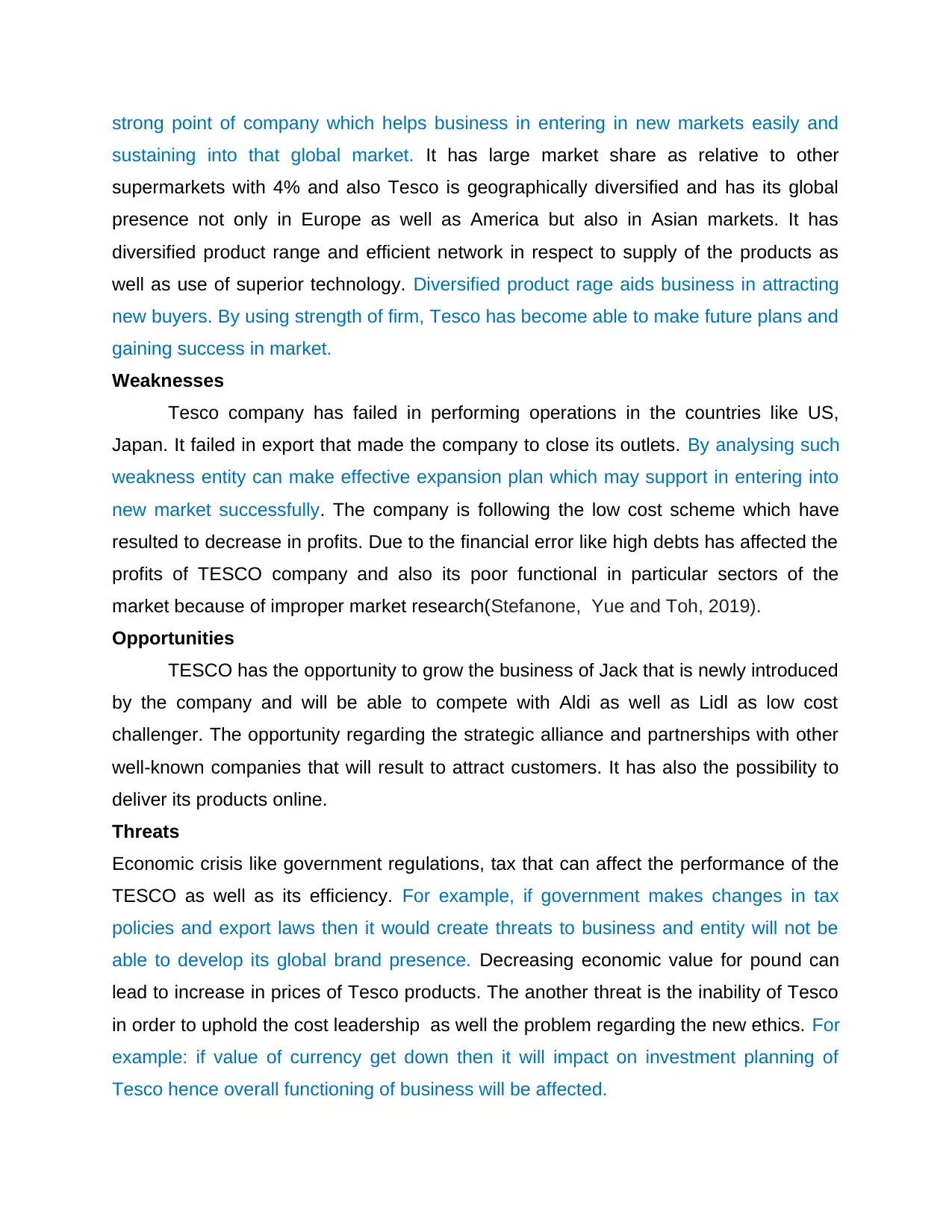
strong point of company which helps business in entering in new markets easily and
sustaining into that global market. It has large market share as relative to other
supermarkets with 4% and also Tesco is geographically diversified and has its global
presence not only in Europe as well as America but also in Asian markets. It has
diversified product range and efficient network in respect to supply of the products as
well as use of superior technology. Diversified product rage aids business in attracting
new buyers. By using strength of firm, Tesco has become able to make future plans and
gaining success in market.
Weaknesses
Tesco company has failed in performing operations in the countries like US,
Japan. It failed in export that made the company to close its outlets. By analysing such
weakness entity can make effective expansion plan which may support in entering into
new market successfully. The company is following the low cost scheme which have
resulted to decrease in profits. Due to the financial error like high debts has affected the
profits of TESCO company and also its poor functional in particular sectors of the
market because of improper market research(Stefanone, Yue and Toh, 2019).
Opportunities
TESCO has the opportunity to grow the business of Jack that is newly introduced
by the company and will be able to compete with Aldi as well as Lidl as low cost
challenger. The opportunity regarding the strategic alliance and partnerships with other
well-known companies that will result to attract customers. It has also the possibility to
deliver its products online.
Threats
Economic crisis like government regulations, tax that can affect the performance of the
TESCO as well as its efficiency. For example, if government makes changes in tax
policies and export laws then it would create threats to business and entity will not be
able to develop its global brand presence. Decreasing economic value for pound can
lead to increase in prices of Tesco products. The another threat is the inability of Tesco
in order to uphold the cost leadership as well the problem regarding the new ethics. For
example: if value of currency get down then it will impact on investment planning of
Tesco hence overall functioning of business will be affected.
sustaining into that global market. It has large market share as relative to other
supermarkets with 4% and also Tesco is geographically diversified and has its global
presence not only in Europe as well as America but also in Asian markets. It has
diversified product range and efficient network in respect to supply of the products as
well as use of superior technology. Diversified product rage aids business in attracting
new buyers. By using strength of firm, Tesco has become able to make future plans and
gaining success in market.
Weaknesses
Tesco company has failed in performing operations in the countries like US,
Japan. It failed in export that made the company to close its outlets. By analysing such
weakness entity can make effective expansion plan which may support in entering into
new market successfully. The company is following the low cost scheme which have
resulted to decrease in profits. Due to the financial error like high debts has affected the
profits of TESCO company and also its poor functional in particular sectors of the
market because of improper market research(Stefanone, Yue and Toh, 2019).
Opportunities
TESCO has the opportunity to grow the business of Jack that is newly introduced
by the company and will be able to compete with Aldi as well as Lidl as low cost
challenger. The opportunity regarding the strategic alliance and partnerships with other
well-known companies that will result to attract customers. It has also the possibility to
deliver its products online.
Threats
Economic crisis like government regulations, tax that can affect the performance of the
TESCO as well as its efficiency. For example, if government makes changes in tax
policies and export laws then it would create threats to business and entity will not be
able to develop its global brand presence. Decreasing economic value for pound can
lead to increase in prices of Tesco products. The another threat is the inability of Tesco
in order to uphold the cost leadership as well the problem regarding the new ethics. For
example: if value of currency get down then it will impact on investment planning of
Tesco hence overall functioning of business will be affected.
⊘ This is a preview!⊘
Do you want full access?
Subscribe today to unlock all pages.

Trusted by 1+ million students worldwide
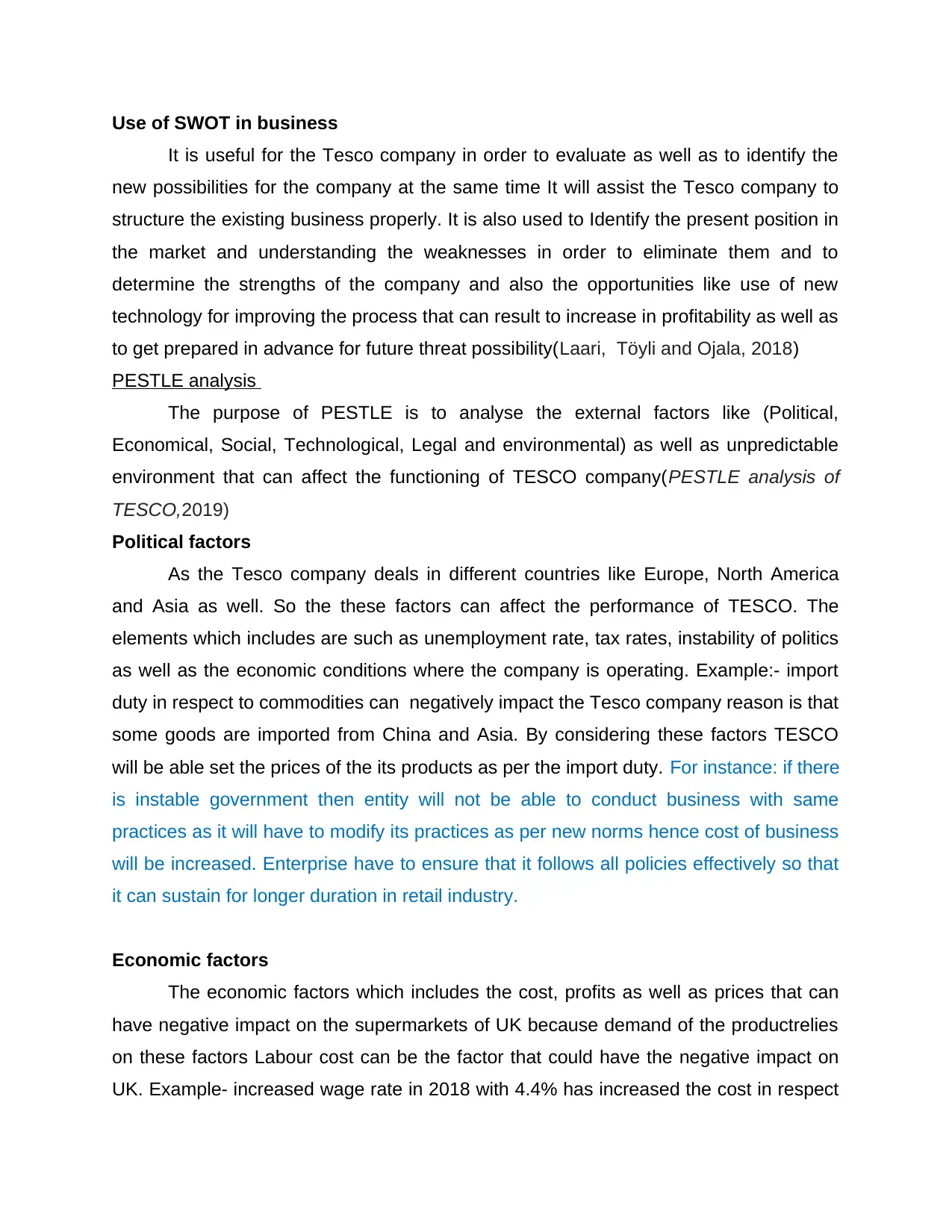
Use of SWOT in business
It is useful for the Tesco company in order to evaluate as well as to identify the
new possibilities for the company at the same time It will assist the Tesco company to
structure the existing business properly. It is also used to Identify the present position in
the market and understanding the weaknesses in order to eliminate them and to
determine the strengths of the company and also the opportunities like use of new
technology for improving the process that can result to increase in profitability as well as
to get prepared in advance for future threat possibility(Laari, Töyli and Ojala, 2018)
PESTLE analysis
The purpose of PESTLE is to analyse the external factors like (Political,
Economical, Social, Technological, Legal and environmental) as well as unpredictable
environment that can affect the functioning of TESCO company(PESTLE analysis of
TESCO,2019)
Political factors
As the Tesco company deals in different countries like Europe, North America
and Asia as well. So the these factors can affect the performance of TESCO. The
elements which includes are such as unemployment rate, tax rates, instability of politics
as well as the economic conditions where the company is operating. Example:- import
duty in respect to commodities can negatively impact the Tesco company reason is that
some goods are imported from China and Asia. By considering these factors TESCO
will be able set the prices of the its products as per the import duty. For instance: if there
is instable government then entity will not be able to conduct business with same
practices as it will have to modify its practices as per new norms hence cost of business
will be increased. Enterprise have to ensure that it follows all policies effectively so that
it can sustain for longer duration in retail industry.
Economic factors
The economic factors which includes the cost, profits as well as prices that can
have negative impact on the supermarkets of UK because demand of the productrelies
on these factors Labour cost can be the factor that could have the negative impact on
UK. Example- increased wage rate in 2018 with 4.4% has increased the cost in respect
It is useful for the Tesco company in order to evaluate as well as to identify the
new possibilities for the company at the same time It will assist the Tesco company to
structure the existing business properly. It is also used to Identify the present position in
the market and understanding the weaknesses in order to eliminate them and to
determine the strengths of the company and also the opportunities like use of new
technology for improving the process that can result to increase in profitability as well as
to get prepared in advance for future threat possibility(Laari, Töyli and Ojala, 2018)
PESTLE analysis
The purpose of PESTLE is to analyse the external factors like (Political,
Economical, Social, Technological, Legal and environmental) as well as unpredictable
environment that can affect the functioning of TESCO company(PESTLE analysis of
TESCO,2019)
Political factors
As the Tesco company deals in different countries like Europe, North America
and Asia as well. So the these factors can affect the performance of TESCO. The
elements which includes are such as unemployment rate, tax rates, instability of politics
as well as the economic conditions where the company is operating. Example:- import
duty in respect to commodities can negatively impact the Tesco company reason is that
some goods are imported from China and Asia. By considering these factors TESCO
will be able set the prices of the its products as per the import duty. For instance: if there
is instable government then entity will not be able to conduct business with same
practices as it will have to modify its practices as per new norms hence cost of business
will be increased. Enterprise have to ensure that it follows all policies effectively so that
it can sustain for longer duration in retail industry.
Economic factors
The economic factors which includes the cost, profits as well as prices that can
have negative impact on the supermarkets of UK because demand of the productrelies
on these factors Labour cost can be the factor that could have the negative impact on
UK. Example- increased wage rate in 2018 with 4.4% has increased the cost in respect
Paraphrase This Document
Need a fresh take? Get an instant paraphrase of this document with our AI Paraphraser
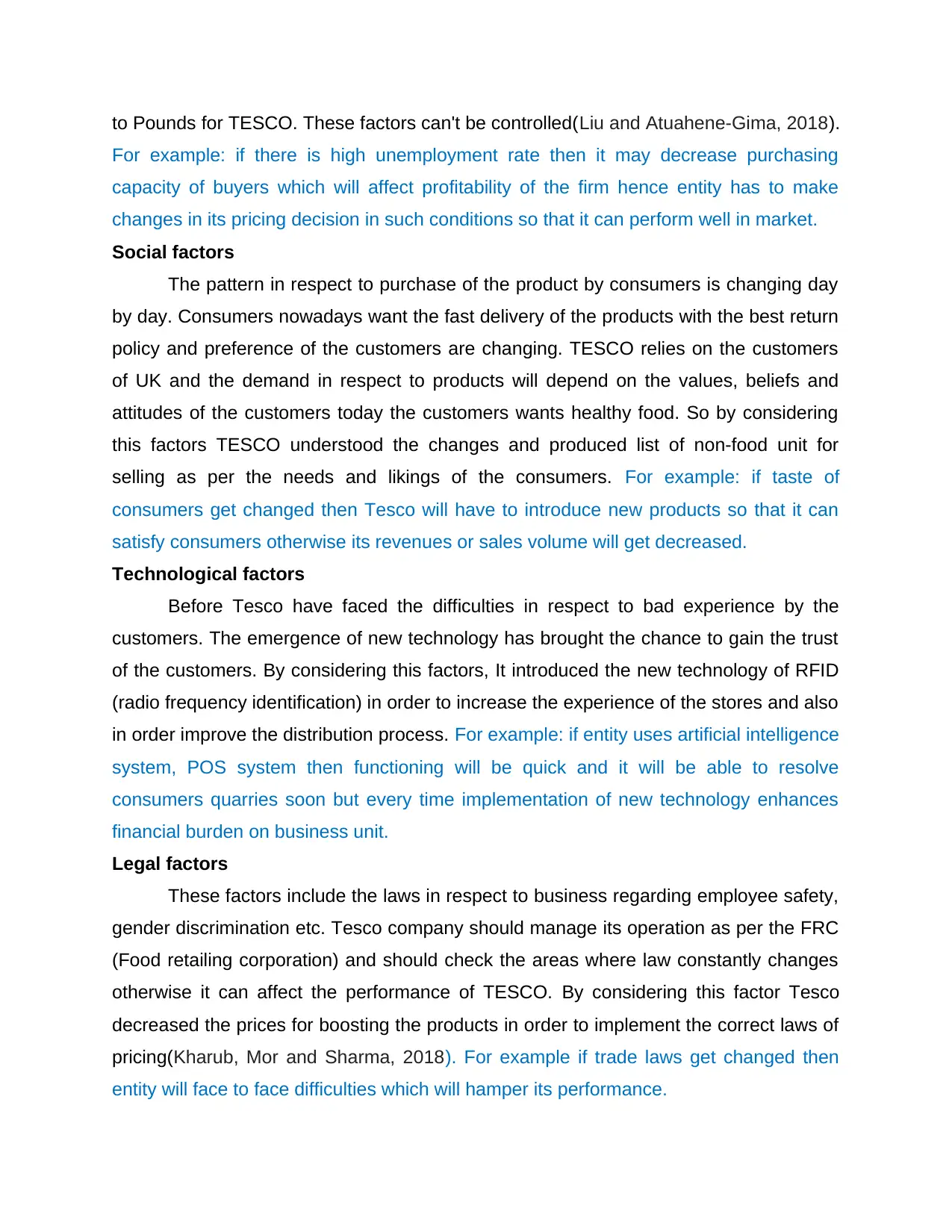
to Pounds for TESCO. These factors can't be controlled(Liu and Atuahene-Gima, 2018).
For example: if there is high unemployment rate then it may decrease purchasing
capacity of buyers which will affect profitability of the firm hence entity has to make
changes in its pricing decision in such conditions so that it can perform well in market.
Social factors
The pattern in respect to purchase of the product by consumers is changing day
by day. Consumers nowadays want the fast delivery of the products with the best return
policy and preference of the customers are changing. TESCO relies on the customers
of UK and the demand in respect to products will depend on the values, beliefs and
attitudes of the customers today the customers wants healthy food. So by considering
this factors TESCO understood the changes and produced list of non-food unit for
selling as per the needs and likings of the consumers. For example: if taste of
consumers get changed then Tesco will have to introduce new products so that it can
satisfy consumers otherwise its revenues or sales volume will get decreased.
Technological factors
Before Tesco have faced the difficulties in respect to bad experience by the
customers. The emergence of new technology has brought the chance to gain the trust
of the customers. By considering this factors, It introduced the new technology of RFID
(radio frequency identification) in order to increase the experience of the stores and also
in order improve the distribution process. For example: if entity uses artificial intelligence
system, POS system then functioning will be quick and it will be able to resolve
consumers quarries soon but every time implementation of new technology enhances
financial burden on business unit.
Legal factors
These factors include the laws in respect to business regarding employee safety,
gender discrimination etc. Tesco company should manage its operation as per the FRC
(Food retailing corporation) and should check the areas where law constantly changes
otherwise it can affect the performance of TESCO. By considering this factor Tesco
decreased the prices for boosting the products in order to implement the correct laws of
pricing(Kharub, Mor and Sharma, 2018). For example if trade laws get changed then
entity will face to face difficulties which will hamper its performance.
For example: if there is high unemployment rate then it may decrease purchasing
capacity of buyers which will affect profitability of the firm hence entity has to make
changes in its pricing decision in such conditions so that it can perform well in market.
Social factors
The pattern in respect to purchase of the product by consumers is changing day
by day. Consumers nowadays want the fast delivery of the products with the best return
policy and preference of the customers are changing. TESCO relies on the customers
of UK and the demand in respect to products will depend on the values, beliefs and
attitudes of the customers today the customers wants healthy food. So by considering
this factors TESCO understood the changes and produced list of non-food unit for
selling as per the needs and likings of the consumers. For example: if taste of
consumers get changed then Tesco will have to introduce new products so that it can
satisfy consumers otherwise its revenues or sales volume will get decreased.
Technological factors
Before Tesco have faced the difficulties in respect to bad experience by the
customers. The emergence of new technology has brought the chance to gain the trust
of the customers. By considering this factors, It introduced the new technology of RFID
(radio frequency identification) in order to increase the experience of the stores and also
in order improve the distribution process. For example: if entity uses artificial intelligence
system, POS system then functioning will be quick and it will be able to resolve
consumers quarries soon but every time implementation of new technology enhances
financial burden on business unit.
Legal factors
These factors include the laws in respect to business regarding employee safety,
gender discrimination etc. Tesco company should manage its operation as per the FRC
(Food retailing corporation) and should check the areas where law constantly changes
otherwise it can affect the performance of TESCO. By considering this factor Tesco
decreased the prices for boosting the products in order to implement the correct laws of
pricing(Kharub, Mor and Sharma, 2018). For example if trade laws get changed then
entity will face to face difficulties which will hamper its performance.
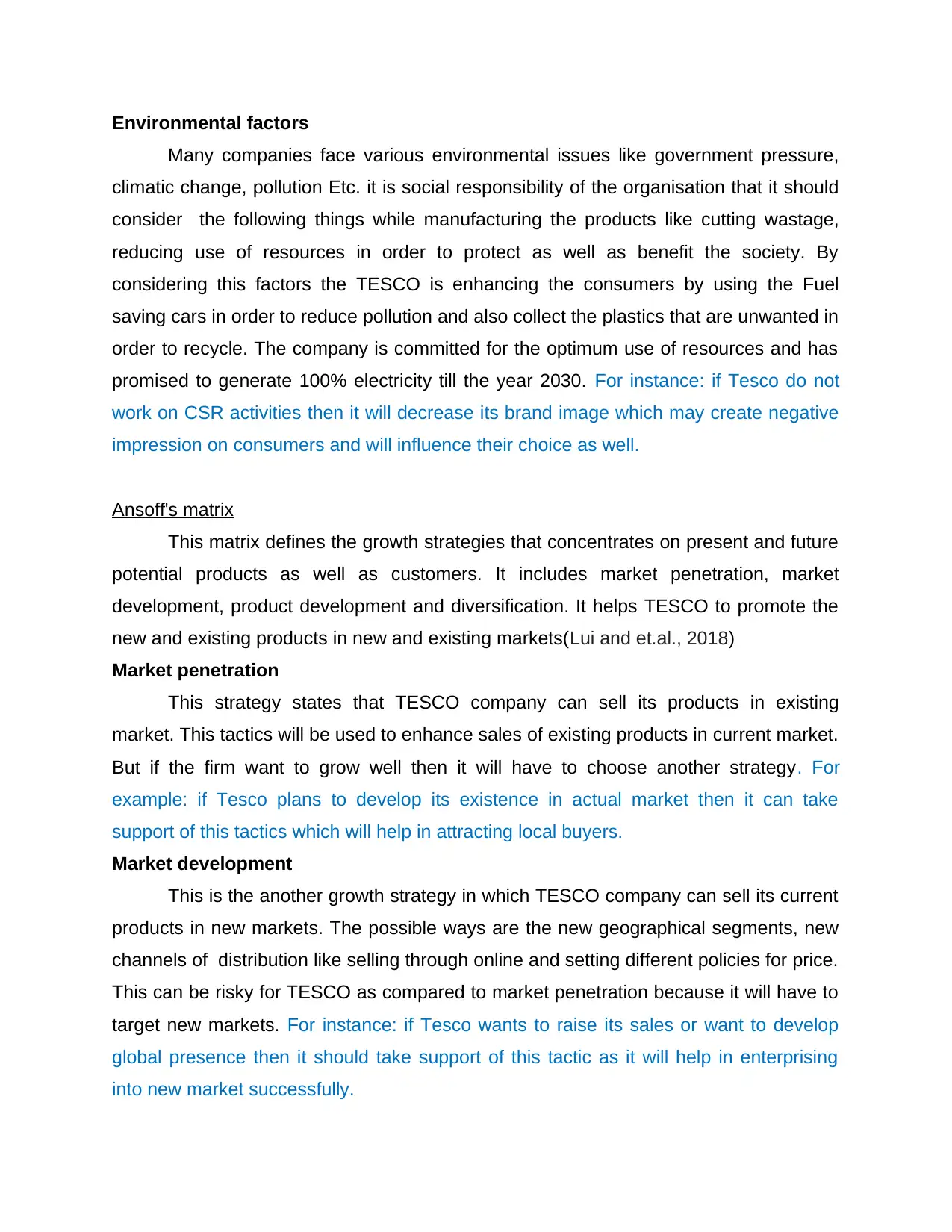
Environmental factors
Many companies face various environmental issues like government pressure,
climatic change, pollution Etc. it is social responsibility of the organisation that it should
consider the following things while manufacturing the products like cutting wastage,
reducing use of resources in order to protect as well as benefit the society. By
considering this factors the TESCO is enhancing the consumers by using the Fuel
saving cars in order to reduce pollution and also collect the plastics that are unwanted in
order to recycle. The company is committed for the optimum use of resources and has
promised to generate 100% electricity till the year 2030. For instance: if Tesco do not
work on CSR activities then it will decrease its brand image which may create negative
impression on consumers and will influence their choice as well.
Ansoff's matrix
This matrix defines the growth strategies that concentrates on present and future
potential products as well as customers. It includes market penetration, market
development, product development and diversification. It helps TESCO to promote the
new and existing products in new and existing markets(Lui and et.al., 2018)
Market penetration
This strategy states that TESCO company can sell its products in existing
market. This tactics will be used to enhance sales of existing products in current market.
But if the firm want to grow well then it will have to choose another strategy. For
example: if Tesco plans to develop its existence in actual market then it can take
support of this tactics which will help in attracting local buyers.
Market development
This is the another growth strategy in which TESCO company can sell its current
products in new markets. The possible ways are the new geographical segments, new
channels of distribution like selling through online and setting different policies for price.
This can be risky for TESCO as compared to market penetration because it will have to
target new markets. For instance: if Tesco wants to raise its sales or want to develop
global presence then it should take support of this tactic as it will help in enterprising
into new market successfully.
Many companies face various environmental issues like government pressure,
climatic change, pollution Etc. it is social responsibility of the organisation that it should
consider the following things while manufacturing the products like cutting wastage,
reducing use of resources in order to protect as well as benefit the society. By
considering this factors the TESCO is enhancing the consumers by using the Fuel
saving cars in order to reduce pollution and also collect the plastics that are unwanted in
order to recycle. The company is committed for the optimum use of resources and has
promised to generate 100% electricity till the year 2030. For instance: if Tesco do not
work on CSR activities then it will decrease its brand image which may create negative
impression on consumers and will influence their choice as well.
Ansoff's matrix
This matrix defines the growth strategies that concentrates on present and future
potential products as well as customers. It includes market penetration, market
development, product development and diversification. It helps TESCO to promote the
new and existing products in new and existing markets(Lui and et.al., 2018)
Market penetration
This strategy states that TESCO company can sell its products in existing
market. This tactics will be used to enhance sales of existing products in current market.
But if the firm want to grow well then it will have to choose another strategy. For
example: if Tesco plans to develop its existence in actual market then it can take
support of this tactics which will help in attracting local buyers.
Market development
This is the another growth strategy in which TESCO company can sell its current
products in new markets. The possible ways are the new geographical segments, new
channels of distribution like selling through online and setting different policies for price.
This can be risky for TESCO as compared to market penetration because it will have to
target new markets. For instance: if Tesco wants to raise its sales or want to develop
global presence then it should take support of this tactic as it will help in enterprising
into new market successfully.
⊘ This is a preview!⊘
Do you want full access?
Subscribe today to unlock all pages.

Trusted by 1+ million students worldwide
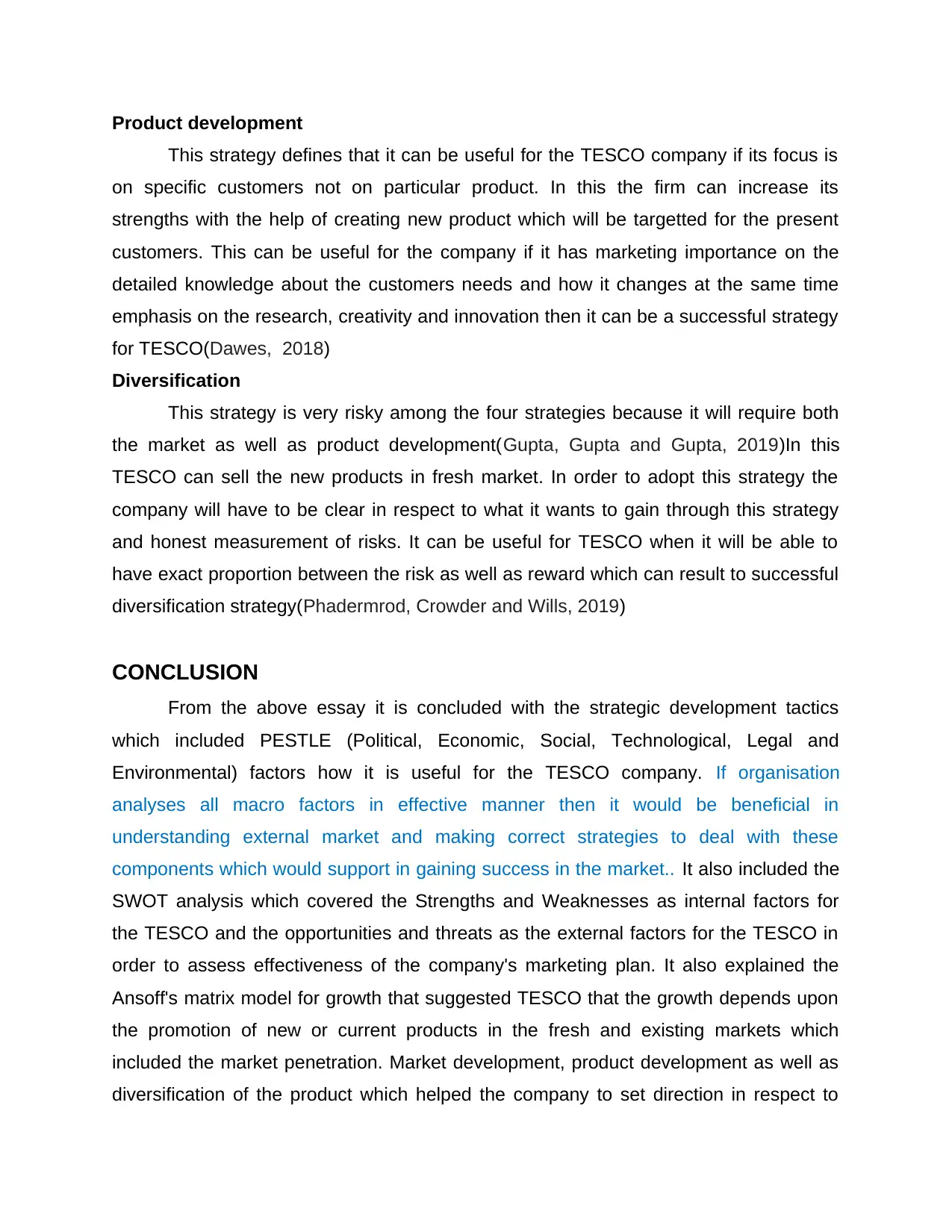
Product development
This strategy defines that it can be useful for the TESCO company if its focus is
on specific customers not on particular product. In this the firm can increase its
strengths with the help of creating new product which will be targetted for the present
customers. This can be useful for the company if it has marketing importance on the
detailed knowledge about the customers needs and how it changes at the same time
emphasis on the research, creativity and innovation then it can be a successful strategy
for TESCO(Dawes, 2018)
Diversification
This strategy is very risky among the four strategies because it will require both
the market as well as product development(Gupta, Gupta and Gupta, 2019)In this
TESCO can sell the new products in fresh market. In order to adopt this strategy the
company will have to be clear in respect to what it wants to gain through this strategy
and honest measurement of risks. It can be useful for TESCO when it will be able to
have exact proportion between the risk as well as reward which can result to successful
diversification strategy(Phadermrod, Crowder and Wills, 2019)
CONCLUSION
From the above essay it is concluded with the strategic development tactics
which included PESTLE (Political, Economic, Social, Technological, Legal and
Environmental) factors how it is useful for the TESCO company. If organisation
analyses all macro factors in effective manner then it would be beneficial in
understanding external market and making correct strategies to deal with these
components which would support in gaining success in the market.. It also included the
SWOT analysis which covered the Strengths and Weaknesses as internal factors for
the TESCO and the opportunities and threats as the external factors for the TESCO in
order to assess effectiveness of the company's marketing plan. It also explained the
Ansoff's matrix model for growth that suggested TESCO that the growth depends upon
the promotion of new or current products in the fresh and existing markets which
included the market penetration. Market development, product development as well as
diversification of the product which helped the company to set direction in respect to
This strategy defines that it can be useful for the TESCO company if its focus is
on specific customers not on particular product. In this the firm can increase its
strengths with the help of creating new product which will be targetted for the present
customers. This can be useful for the company if it has marketing importance on the
detailed knowledge about the customers needs and how it changes at the same time
emphasis on the research, creativity and innovation then it can be a successful strategy
for TESCO(Dawes, 2018)
Diversification
This strategy is very risky among the four strategies because it will require both
the market as well as product development(Gupta, Gupta and Gupta, 2019)In this
TESCO can sell the new products in fresh market. In order to adopt this strategy the
company will have to be clear in respect to what it wants to gain through this strategy
and honest measurement of risks. It can be useful for TESCO when it will be able to
have exact proportion between the risk as well as reward which can result to successful
diversification strategy(Phadermrod, Crowder and Wills, 2019)
CONCLUSION
From the above essay it is concluded with the strategic development tactics
which included PESTLE (Political, Economic, Social, Technological, Legal and
Environmental) factors how it is useful for the TESCO company. If organisation
analyses all macro factors in effective manner then it would be beneficial in
understanding external market and making correct strategies to deal with these
components which would support in gaining success in the market.. It also included the
SWOT analysis which covered the Strengths and Weaknesses as internal factors for
the TESCO and the opportunities and threats as the external factors for the TESCO in
order to assess effectiveness of the company's marketing plan. It also explained the
Ansoff's matrix model for growth that suggested TESCO that the growth depends upon
the promotion of new or current products in the fresh and existing markets which
included the market penetration. Market development, product development as well as
diversification of the product which helped the company to set direction in respect to
Paraphrase This Document
Need a fresh take? Get an instant paraphrase of this document with our AI Paraphraser
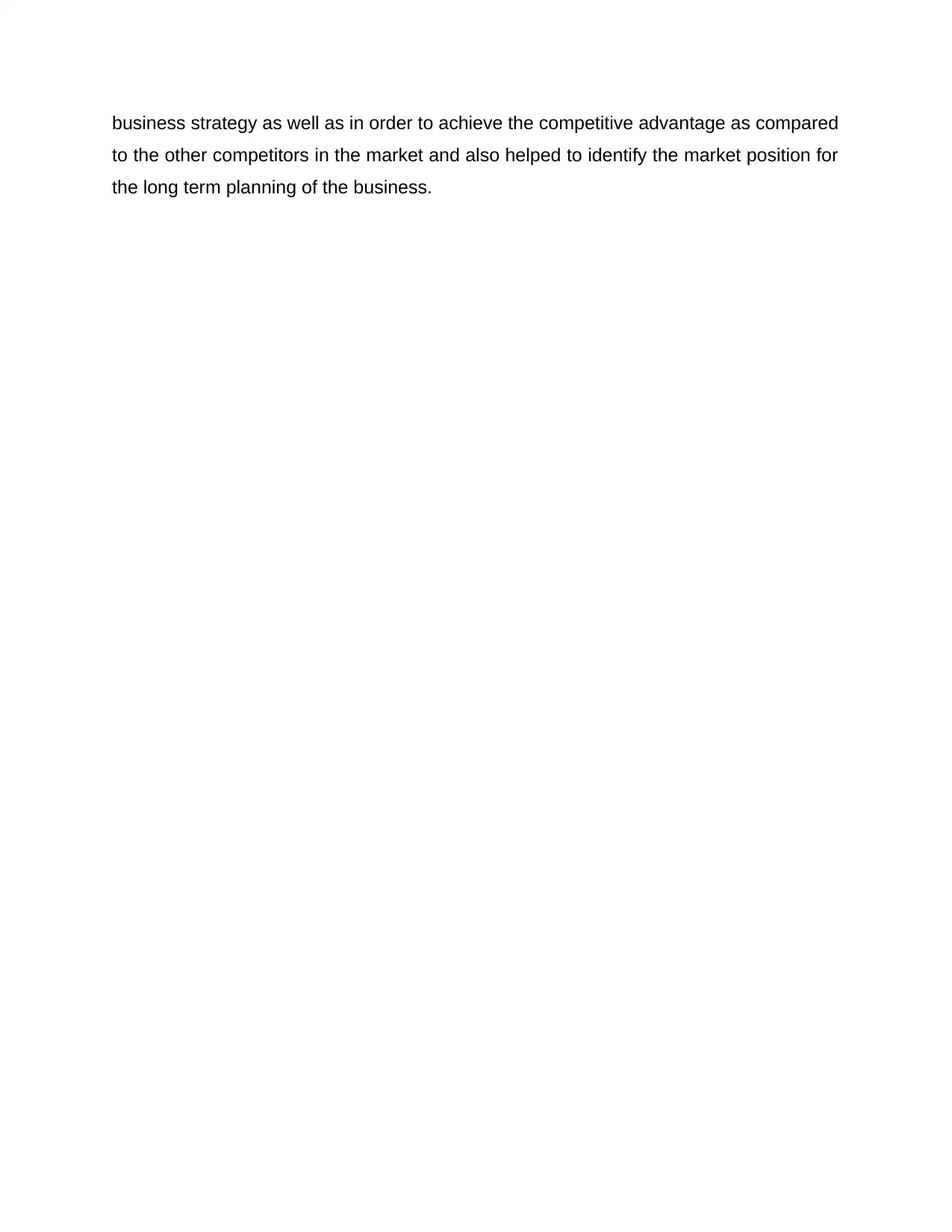
business strategy as well as in order to achieve the competitive advantage as compared
to the other competitors in the market and also helped to identify the market position for
the long term planning of the business.
to the other competitors in the market and also helped to identify the market position for
the long term planning of the business.
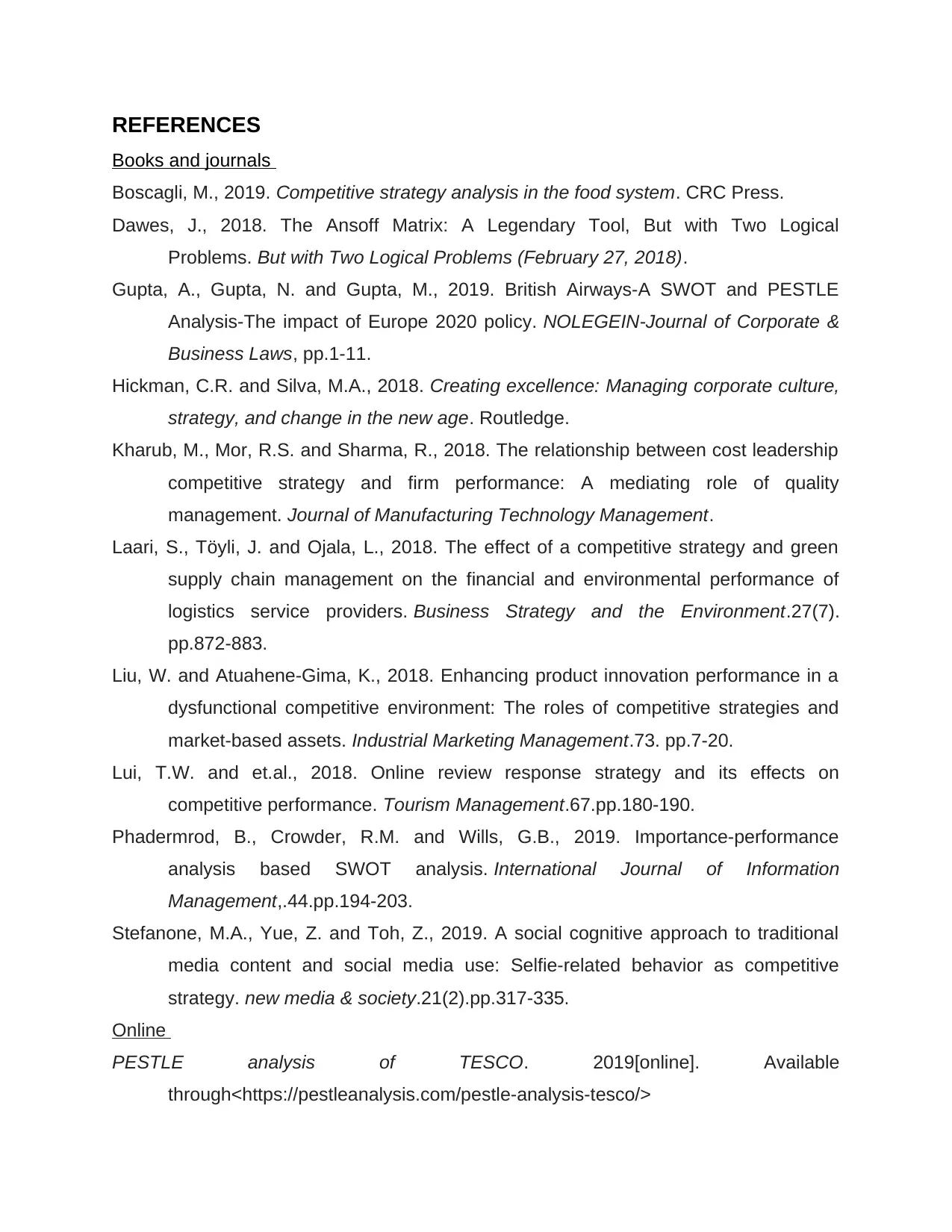
REFERENCES
Books and journals
Boscagli, M., 2019. Competitive strategy analysis in the food system. CRC Press.
Dawes, J., 2018. The Ansoff Matrix: A Legendary Tool, But with Two Logical
Problems. But with Two Logical Problems (February 27, 2018).
Gupta, A., Gupta, N. and Gupta, M., 2019. British Airways-A SWOT and PESTLE
Analysis-The impact of Europe 2020 policy. NOLEGEIN-Journal of Corporate &
Business Laws, pp.1-11.
Hickman, C.R. and Silva, M.A., 2018. Creating excellence: Managing corporate culture,
strategy, and change in the new age. Routledge.
Kharub, M., Mor, R.S. and Sharma, R., 2018. The relationship between cost leadership
competitive strategy and firm performance: A mediating role of quality
management. Journal of Manufacturing Technology Management.
Laari, S., Töyli, J. and Ojala, L., 2018. The effect of a competitive strategy and green
supply chain management on the financial and environmental performance of
logistics service providers. Business Strategy and the Environment.27(7).
pp.872-883.
Liu, W. and Atuahene-Gima, K., 2018. Enhancing product innovation performance in a
dysfunctional competitive environment: The roles of competitive strategies and
market-based assets. Industrial Marketing Management.73. pp.7-20.
Lui, T.W. and et.al., 2018. Online review response strategy and its effects on
competitive performance. Tourism Management.67.pp.180-190.
Phadermrod, B., Crowder, R.M. and Wills, G.B., 2019. Importance-performance
analysis based SWOT analysis. International Journal of Information
Management,.44.pp.194-203.
Stefanone, M.A., Yue, Z. and Toh, Z., 2019. A social cognitive approach to traditional
media content and social media use: Selfie-related behavior as competitive
strategy. new media & society.21(2).pp.317-335.
Online
PESTLE analysis of TESCO. 2019[online]. Available
through<https://pestleanalysis.com/pestle-analysis-tesco/>
Books and journals
Boscagli, M., 2019. Competitive strategy analysis in the food system. CRC Press.
Dawes, J., 2018. The Ansoff Matrix: A Legendary Tool, But with Two Logical
Problems. But with Two Logical Problems (February 27, 2018).
Gupta, A., Gupta, N. and Gupta, M., 2019. British Airways-A SWOT and PESTLE
Analysis-The impact of Europe 2020 policy. NOLEGEIN-Journal of Corporate &
Business Laws, pp.1-11.
Hickman, C.R. and Silva, M.A., 2018. Creating excellence: Managing corporate culture,
strategy, and change in the new age. Routledge.
Kharub, M., Mor, R.S. and Sharma, R., 2018. The relationship between cost leadership
competitive strategy and firm performance: A mediating role of quality
management. Journal of Manufacturing Technology Management.
Laari, S., Töyli, J. and Ojala, L., 2018. The effect of a competitive strategy and green
supply chain management on the financial and environmental performance of
logistics service providers. Business Strategy and the Environment.27(7).
pp.872-883.
Liu, W. and Atuahene-Gima, K., 2018. Enhancing product innovation performance in a
dysfunctional competitive environment: The roles of competitive strategies and
market-based assets. Industrial Marketing Management.73. pp.7-20.
Lui, T.W. and et.al., 2018. Online review response strategy and its effects on
competitive performance. Tourism Management.67.pp.180-190.
Phadermrod, B., Crowder, R.M. and Wills, G.B., 2019. Importance-performance
analysis based SWOT analysis. International Journal of Information
Management,.44.pp.194-203.
Stefanone, M.A., Yue, Z. and Toh, Z., 2019. A social cognitive approach to traditional
media content and social media use: Selfie-related behavior as competitive
strategy. new media & society.21(2).pp.317-335.
Online
PESTLE analysis of TESCO. 2019[online]. Available
through<https://pestleanalysis.com/pestle-analysis-tesco/>
⊘ This is a preview!⊘
Do you want full access?
Subscribe today to unlock all pages.

Trusted by 1+ million students worldwide

1 out of 10
Related Documents
Your All-in-One AI-Powered Toolkit for Academic Success.
+13062052269
info@desklib.com
Available 24*7 on WhatsApp / Email
![[object Object]](/_next/static/media/star-bottom.7253800d.svg)
Unlock your academic potential
Copyright © 2020–2025 A2Z Services. All Rights Reserved. Developed and managed by ZUCOL.



